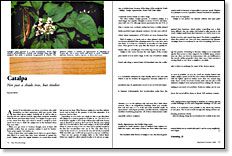
Synopsis: Those who work catalpa probably liked it so much they have been reluctant to spread the word, Jon Arno writes. It’s hard to find, but it’s a fine cabinetwood and isn’t that expensive. There are two native species in the U.S., and Arno explains their history and tells you why it’s rare and what makes it fun to work with. He shares tips on air-drying it yourself in case the only way you can find some is to cut down a tree.
Ask any 10 woodworkers you know, even those who pride themselves on their experience with rare woods, what they think about catalpa. Probably all 10 will be able to describe the tree with its unusual, cigar-shape seedpods, beautiful white flowers and heart-shape leaves. You might even get a story or two about how they once tried to smoke a seedpod or how much fun it was to climb the catalpa tree in the backyard when they were kids.
When you get down to business though, most of them will probably confess they are unaware catalpa is used for lumber. Fence posts maybe, but lumber no.
If any of them have used catalpa wood, there is a good chance they liked it so much they have been reluctant, to spread the word. Catalpa, given the supply situation, is a secret they would just as soon see kept. Why? Because catalpa is a very fine cabinetwood, and at least at the present, it isn’t that expensive. It is, however, hard to find.
Depending on your luck, you might be able to get kiln-dried, S2S catalpa in a common grade for as little as $1 per bd. ft. at a local lumber supplier. A few of the well-stocked mail-order houses carry it, listed for as much as $4.75 per bd. ft. But the more typical place for a woodworker to find some catalpa is at the local sawmill, where it comes in a log or two at a time and is quickly bought by the first few woodworkers who see it. The only other way to come by the wood is to cut down the tree and air-dry it yourself. With very little care, it will end up as good as any you could buy.
There are two species of catalpa native to the United States. Either tree might be called catawba locally or be known as cigar tree or Indian-bean, because of the shape of the seedpods. Southern catalpa, Catalpa bignonioides, is found in Gulf Coast states from the Florida panhandle west to Louisiana. Used locally for fence posts and occasionally for lumber, this small tree is not commonly found outside its native range.
The other catalpa, Catalpa speciosa, or northern catalpa, is a much larger tree capable of heights in excess of 100 ft. and diameters well over 5 ft., although mature specimens that are 70 ft. to 80 ft. tall and 3 ft. to 4 ft. in diameter are more typical. For more than a century now, northern catalpa has been a widely planted ornamental, especially in the Midwest. It is a fast grower and very hardy, provided it gets adequate moisture. It is also very cold tolerant. I have seen catalpa growing as far north as Minneapolis, where winter temperatures of 30°-below are more frequent than most of the residents care to think about.
From Fine Woodworking #72
For the full article, download the PDF below:
Fine Woodworking Recommended Products

AnchorSeal Log and Lumber End-Grain Sealer

DeWalt 735X Planer

Ridgid R4331 Planer





















Log in or create an account to post a comment.
Sign up Log in